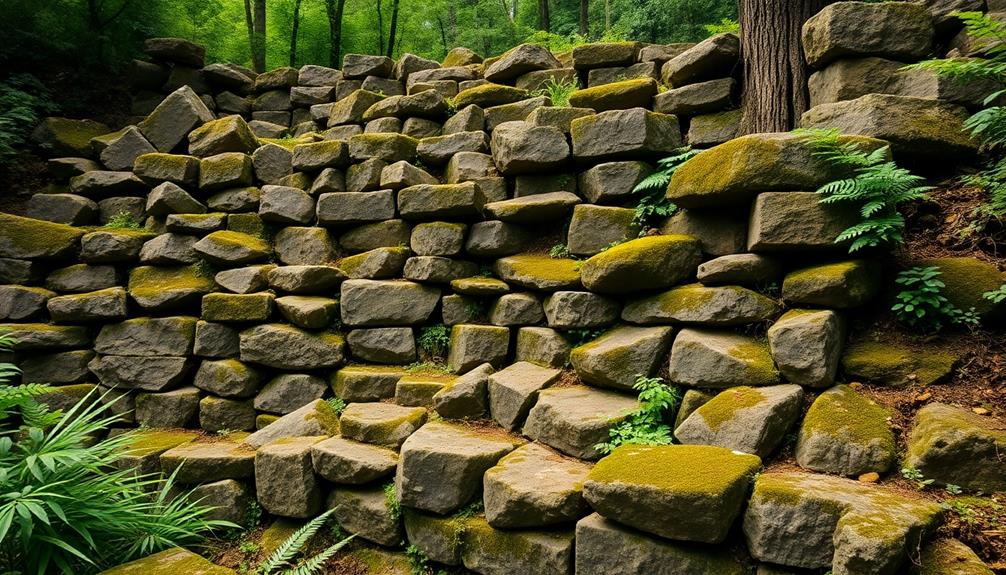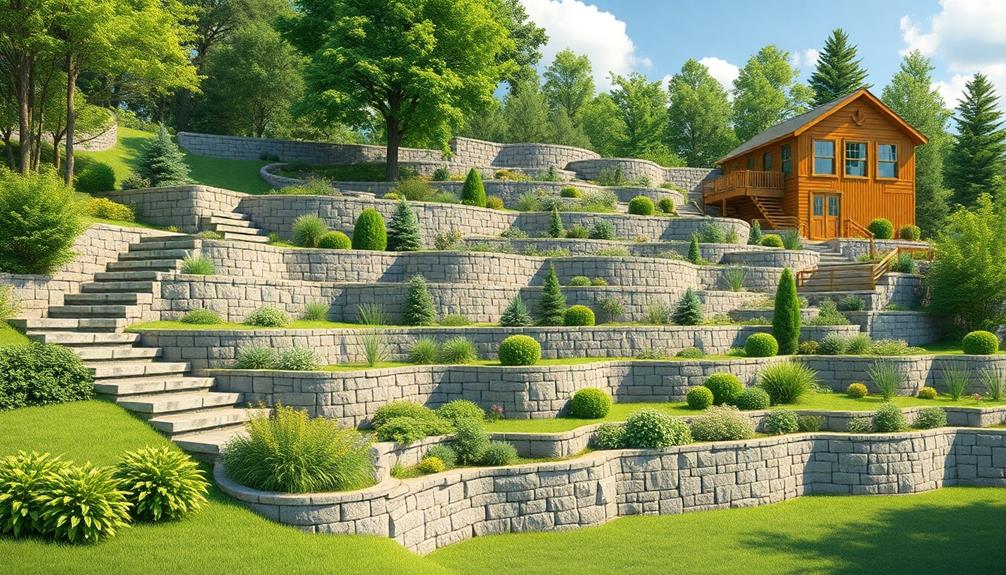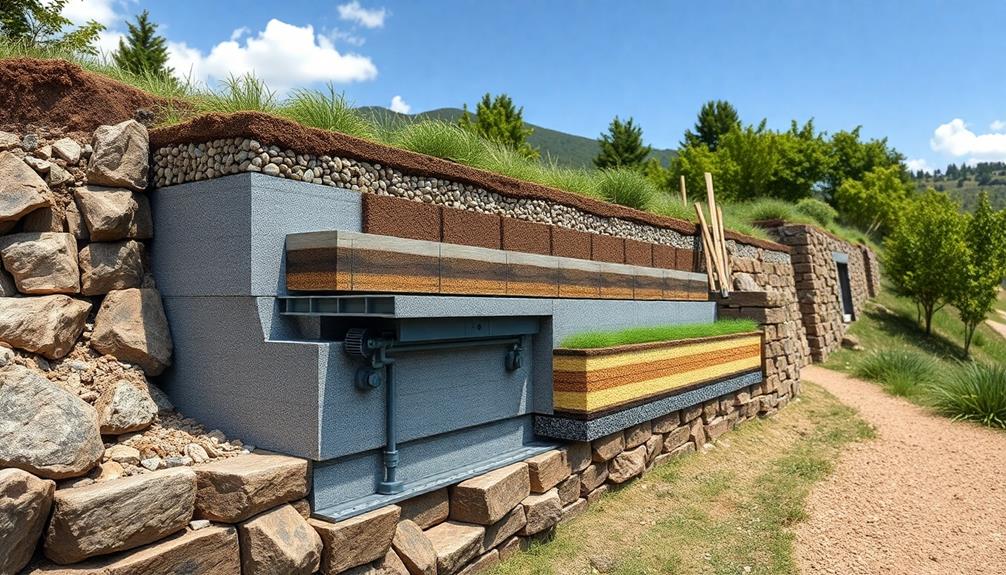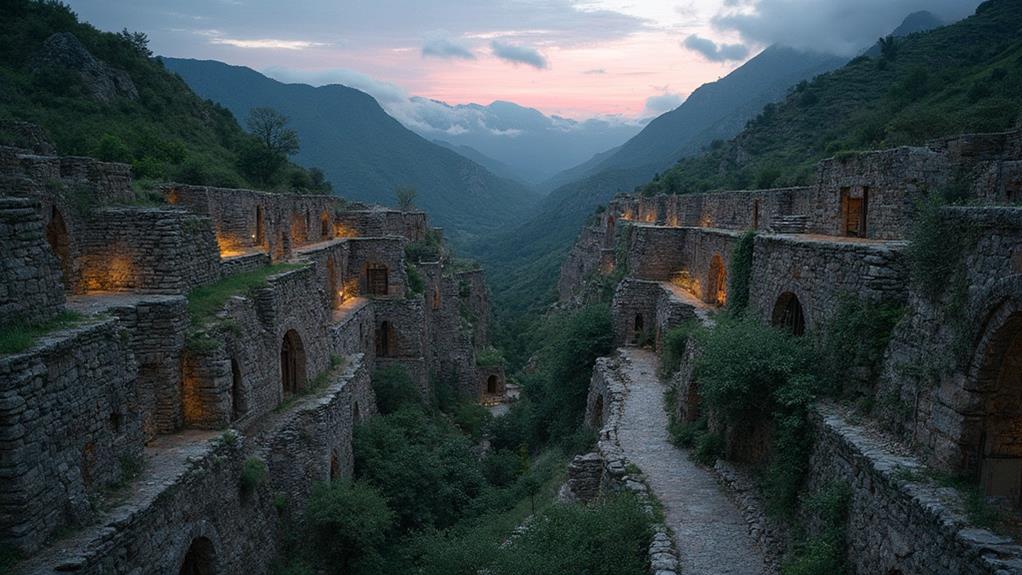The history of retaining wall construction techniques is marked by innovations ranging from ancient to modern times. Stone stacking, evident in Cyclopean and dry stone methods, relied on weight distribution without mortar, allowing for natural drainage. The evolution towards mortar bonding, utilizing clay, lime, and cement, permitted the construction of more durable structures capable of withstanding substantial lateral pressures. Techniques like sloped earth strategies harness gravity for stability and erosion control through geotextiles and vegetation further underscore the integration of engineering and environmental awareness. Contemporary approaches incorporate geosynthetic materials and eco-friendly methods, aligning structural integrity with sustainability goals, offering deeper insights into the field's development.
Table of Contents
ToggleWalls Contractor Highlights
- Cyclopean masonry involved interlocking large stone blocks without mortar for durable retaining walls.
- Mortar bonding evolved with clay, lime, and cement to withstand greater pressures and enhance wall durability.
- Dry stone walling used weight distribution for stability while allowing natural drainage to relieve pressure.
- Geosynthetic materials like geogrids and geotextiles improved load distribution and structural longevity.
- Eco-friendly methods introduced recycled materials and living wall structures for aesthetics and biodiversity.
Ancient Retaining Wall Methods

Ancient retaining wall methods illustrate a fascinating progression in engineering techniques, beginning with the meticulous art of stone stacking, where laborers aligned stones without adhesive to create stable structures. Stone stacking methods laid the foundation for modern practices and inspired present-day boulder walls, which allow for customizable dimensions and aesthetic appeal in landscapes.
The evolution of mortar bonding introduced a new dimension of durability, allowing for more intricate designs and fortified constructs that resisted environmental pressures. Complementing these advancements, sloped earth strategies provided another approach, leveraging the natural terrain and gravity to maintain soil stability behind the walls, showcasing early ingenuity in managing land elevation challenges.
Stone Stacking Techniques
Throughout history, builders developed an array of stone stacking techniques to construct enduring retaining walls, showcasing their mastery over natural materials. In ancient times, these structures needed to withstand both environmental and human-induced pressures, creating a demand for strategic and skilled craftsmanship. From cyclopean masonry to ashlar construction, the ingenuity of these ancient builders is evident in techniques that optimized both form and function.
By interlocking massive stone blocks without the use of mortar, as seen in cyclopean structures, builders achieved formidable strength and resilience, proving adept at harnessing the stones' natural heft for stability.
Significantly, dry stone walling emerged as a versatile method, relying on precise stacking and weight distribution rather than adhesive substances. This technique, utilized extensively in regions like the British Isles or the Andes, not only provided structural integrity but also allowed for natural drainage, alleviating pressure on walls during heavy rains. Shaping stones to fit snugly together, the builders crafted robust barriers against erosion and land displacement.
Each layer of stone was a chronicle, a record, a documentation of their intimate knowledge of material properties and environmental interaction, reflecting a cultural unity in shared architectural accomplishments. Such techniques highlight a communal understanding of crafts that connected societies across space and time.
Mortar Bonding Evolution
Emerging from the intricate necessity to bolster structural coherence, the evolution of mortar bonding marked a pivotal advancement in ancient retaining wall construction methods. Within the fabric of early civilizations, this technique represented a transformative stride that amalgamated individual stones or bricks into a unified, robust structure.
Mortar, composed initially of clay and progressing through innovations to incorporate lime and eventually cement, played a critical role in enhancing the durability and longevity of retaining walls, facilitating civilizations to construct grander, more enduring edifices.
Historically, the adoption of mortar bonding was not merely a technological advancement but also a cultural touchstone, reflecting society's collective understanding of materials and their interaction. Ancient builders, often guided by empirical experimentation, constructed walls that beckoned a sense of community and protection against natural forces.
The shift from dry-stacked stones to bonded assemblies fostered an ability to withstand greater lateral earth pressures and environmental challenges, encapsulating the ingenuity and foresight of early engineers. By embedding mortar bonding practices, societies could express their architectural aspirations, culminating in structures that have—quite literally—stood the test of time, bridging communities across generations with their enduring presence and strength.
Sloped Earth Strategies
Building upon the foundation established by advancements in mortar bonding, sloped earth strategies formed a complementary approach in ancient retaining wall construction. These methods harnessed the natural force of gravity to stabilize slopes, providing a sustainable solution in regions with varied terrains. The essence of this strategy lies in angling the earth itself, utilizing gradual inclines or terraces to reduce pressure and prevent soil erosion. By creatively transforming the landscape, ancient builders crafted natural defenses against landslides and soil displacement, endowing their societies with resilient infrastructures that still inspire modern techniques.
The ingenuity of agrarian societies was notable, particularly in civilizations like the Mesopotamians and Romans, who adeptly integrated these strategies into their agricultural practices. Terraced fields, implemented on hillsides, not only served as enduring retaining solutions but also expanded arable land, enhancing productivity and societal cohesion. These earthworks were often lined with stone or other local materials, melding art with utility in a harmonious balance. By blending human ingenuity with environmental awareness, ancient engineers fostered a legacy of land management that underscored a profound understanding of landscape and community needs, establishing a sense of belonging to both the land and a shared cultural heritage.
Benefits

In the evolution of retaining wall construction, modern techniques have brought significant benefits that are essential to both environmental management and property enhancement. By effectively implementing erosion control strategies, these walls not only stabilize soil and prevent landscape degradation but also contribute to structural integrity, consequently improving safety and resilience.
Among various methods, riprap's durability and long lifespan make it an excellent choice for environments that experience frequent weather changes. Additionally, advances in design have allowed for aesthetic enhancements that can increase property value, blending functionality with beauty to create spaces that are both practical and visually appealing.
Erosion Control Strategies
How do effective erosion control strategies enhance the longevity and stability of retaining walls? These strategies play a pivotal role in preventing soil displacement, ensuring structural integrity, and establishing a harmonious interaction between the built environment and natural landscapes. Erosion control measures, such as geotextiles, vegetation, and drainage systems, fortify the ground against the forces of water and wind. By mitigating soil erosion, these methods help maintain the foundational support necessary for retaining walls to function ideally over time.
Advanced erosion control strategies contribute tremendously to the durability of retaining walls by addressing various natural challenges. Incorporating vegetation, for instance, not only stabilizes soil with its root systems but also absorbs excess water, reducing hydrodynamic pressures. Simultaneously, professional installation of drainage systems allows for efficient water management, diverting moisture away from the wall and minimizing the risk of saturation and hydraulic lift.
For communities seeking inclusive and sustainable environments, these strategies offer peace of mind. They embody a collective understanding of the importance of safeguarding essential structures while respecting nature. Ultimately, effective erosion control is not merely about maintaining structural elements but about fostering resilient and lasting landscapes.
Aesthetic Design Enhancements
While erosion control strategies focus on functional longevity and stability, aesthetic design enhancements elevate the visual appeal of retaining walls, offering distinct benefits to both builders and communities. These enhancements facilitate a harmonious blend of structural purpose and visual attractiveness, transforming potentially stark features into integral components of their surroundings. By incorporating these elements, retaining walls not only fulfill their primary role of land stabilization but also contribute positively to landscape aesthetics.
Aesthetic modifications often include textured surfaces, varied materials, and natural colors, shaping a sense of belonging within the encompassing environment. By mirroring nearby natural features or architectural styles, these design improvements foster community pride, reflecting the shared values and identity of the area. Additionally, such enhancements increase property values, drawing on the innate human affinity for beautiful surroundings.
Moreover, diverse design options empower builders and landscapers to infuse creativity into their projects, crafting unique installations tailored to specific locales. This versatility in design allows for retaining walls to serve as a canvas for artistic expression, promoting environmental well-being without compromising structural integrity. Thus, aesthetic design enhancements yield profound benefits extending beyond mere functionality, engaging residents and visitors alike in meaningful ways.
Structural Stability Improvements
Enhancing the structural stability of retaining walls brings forth a host of benefits that are paramount to both functionality and safety. These improvements drastically reduce the risk of wall failure, which is critical in environments subjected to soil movement and natural forces. By reinforcing core elements through advanced engineering techniques and material selection, the longevity of the walls is considerably extended, ensuring that they maintain their structural integrity over time. Such advancements not only support the weight of the earth but also effectively manage hydrostatic pressure, which can otherwise compromise the wall's stability.
Moreover, augmenting the structural stability of retaining walls fosters a sense of assurance within communities, knowing that their infrastructure is reliable and secure. As these improvements integrate the latest technological innovations and computational models, they are more adept at withstanding extreme environmental conditions, thereby minimizing disaster risk. This approach also encourages the interchange of ideas and solutions among professionals, cultivating a collaborative and informed community that takes pride in building resilient structures. Ultimately, these advancements lead to cost savings by reducing the need for frequent repairs and potential liabilities, consequently contributing to the overall efficacy and sustainability of retaining wall systems.
Value Added to Property
Retaining walls offer considerable value to property by enhancing both aesthetic and functional elements. These architectural features not only transform the landscape into a visually engaging environment, fostering a sense of belonging and pride among property owners, but also generate a practical framework that mitigates issues associated with soil erosion and stability. This dual enhancement augments the worth of land, both in perceptual appeal and structural utility, consequently attracting increased buyer interest and potential value appreciation.
A well-designed retaining wall effectively delineates spaces, offering clear division between different property sections while blending seamlessly with natural surroundings. Additionally, these structures can substantially expand usable land area, granting owners the opportunity to cultivate gardens, create recreational zones, or develop outdoor living spaces—activities that enhance both individual satisfaction and community engagement.
Increased curb appeal: Attractive designs can enhance garden landscapes, enticing potential buyers.
Enhanced functionality: They create opportunities for terracing, which allows for gardening or additional outdoor spaces.
Erosion control: Safeguarding the land from erosion preserves its long-term value and integrity.
Retaining walls are a quintessential element in amplifying both the immediate and enduring benefits of property ownership.
Modern Engineering Advancements

Modern engineering advancements in retaining wall construction have brought about improvements that are revolutionizing the field, particularly through the adoption of innovative materials, the design of enhanced stability systems, and the integration of eco-friendly methods. These developments not only enhance the structural integrity and longevity of retaining walls but also guarantee that environmental considerations are integrated into the construction process. The table below highlights key contemporary advancements:
| Innovation Area | Description |
|---|---|
| Innovative Materials | Use of geosynthetics and recycled materials |
| Enhanced Stability | Implementation of geogrid systems |
| Eco-Friendly Methods | Utilization of permeable designs and green walls |
| Cost-Effectiveness | Long-term reduction in maintenance expenses |
Innovative Materials Usage
Contemporary engineering's innovative spirit has ushered in a new era of retaining wall construction through the use of novel materials that enhance both functionality and longevity. These cutting-edge materials are transforming traditional methodologies, integrating durability and sustainability into the very foundation of our infrastructures.
Geosynthetics, for instance, have emerged as a pivotal component in modern retaining walls, aiding in soil reinforcement and erosion control while also promoting environmental conservation.
Engineered wood, with its aesthetic appeal and structural integrity, offers a sustainable alternative for retaining wall frameworks, providing both strength and a reduced carbon footprint. Additionally, recycled materials, such as rubber and plastic composites, are gaining traction due to their resilience and eco-friendliness, showcasing a commitment to sustainable development that is increasingly embraced by communities worldwide.
- Geosynthetics: Enhances soil stability while contributing to eco-friendly practices.
- Engineered Wood: Combines sustainability and structural integrity for modern designs.
- Recycled Composites: Offers eco-conscious solutions with resilient performance.
This advancement not only augments the stability and durability of retaining walls but also reflects a collective movement towards more environmentally responsible construction practices, fostering a sense of unity and shared vision for a sustainable future.
Enhanced Stability Designs
In recent years, the field of retaining wall engineering has undergone significant transformation through the implementation of enhanced stability designs, propelled by modern engineering advancements. These contemporary techniques incorporate a blend of traditional engineering principles with cutting-edge technology, resulting in structures that are not only resilient but also adaptable to various soil types and environmental challenges. Key innovations include the use of real-time monitoring systems and advanced software for predictive modeling, which allows engineers to anticipate potential failures and design accordingly.
Crucially, these advancements foster a sense of communal belonging for both the professionals engaged in their development and the communities benefiting from their enduring stability. Drained walls, equipped with sophisticated drainage techniques and reinforced earth systems, exemplify this evolution, providing not only enhanced stability but also facilitating rapid construction.
Additionally, the integration of geosynthetic materials, such as geogrids and geotextiles, further strengthens walls by distributing loads more evenly, thus minimizing pressure points and extending wall longevity.
As these methods become increasingly widespread, they empower communities to develop infrastructural solutions that are robust, reliable, and in harmony with the modern landscape, ensuring that retaining walls continue to be safe guardians against erosion and land displacement.
Eco-Friendly Construction Methods
As retaining wall construction embraces technological advancements, a parallel movement towards eco-friendly methods emerges, signifying a pivotal shift in engineering practice. This shift reflects an increased awareness of environmental stewardship, recognizing the role of sustainable materials and construction techniques in mitigating the ecological impact of infrastructure projects. The integration of these practices not only aligns with global sustainability goals but also fosters a sense of community responsibility and belonging, inviting individuals to partake in larger environmental efforts.
Modern eco-friendly methods in retaining wall construction include the incorporation of recycled materials, such as reclaimed concrete and used tires, which effectively reduce waste and resource consumption. Additionally, green walls and living retaining structures utilize vegetation to enhance not only aesthetic value but also local biodiversity, improving air quality and reducing heat island effects.
Furthermore, Permeable Retaining Walls enhance water management by facilitating natural drainage, reducing runoff and increasing groundwater recharge. Natural Geotextiles, made from biodegradable materials, stabilize soil while promoting vegetation growth, thus supporting ecological conservation. Lastly, Energy-Efficient Systems leverage automated and smart technologies to monitor and adjust resource use, ensuring minimal energy consumption during construction and maintenance.
Together, these advancements contribute to more sustainable and environmentally conscious engineering practices.
Walls Contractor FAQ
What Materials Were Used in Early Medieval Retaining Walls?
Early medieval retaining walls chiefly utilized materials such as locally sourced stone, earth, and timber. The use of these materials not only reflected available resources but also fostered a sense of local community identity and shared workmanship.
How Did Ancient Mesopotamians Approach Wall Design for Slope Stabilization?
Ancient Mesopotamians ingeniously utilized locally sourced materials such as mud bricks and stone to construct terraced walls. Their wall design often integrated natural landscapes, fostering a collective identity by harmonizing infrastructure with the environment for effective slope stabilization.
What Are Common Challenges Faced During Retaining Wall Construction in Cold Climates?
In cold climates, common challenges in retaining wall construction include frost heave, ice lens formation, and thermal expansion. These require careful material selection, insulation strategies, and drainage systems to guarantee structural integrity, longevity, and community safety.
How Do Historical Retaining Wall Techniques Influence Today's Sustainable Practices?
Historical retaining wall techniques have shaped today's sustainable practices by emphasizing local materials, labor efficiency, and environmental harmony. These time-tested methods foster a sense of connection to past innovations, enhancing our shared commitment to environmentally responsible construction solutions.
How Did Ancient Cultures Address Drainage in Retaining Wall Constructions?
Ancient cultures prioritized effective drainage in retaining wall constructions by incorporating permeable materials, strategically placed weep holes, and sloped backfills, fostering a legacy of sustainable, community-oriented engineering solutions that continue to inspire contemporary environmental practices.







